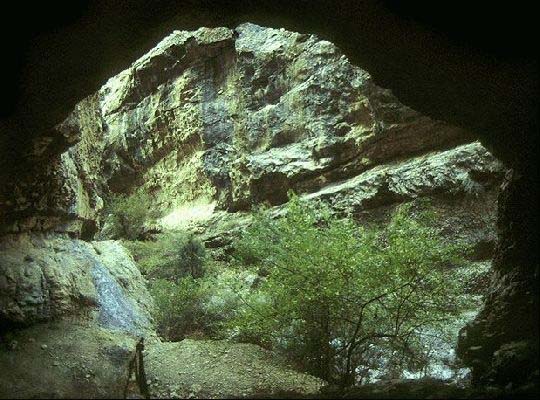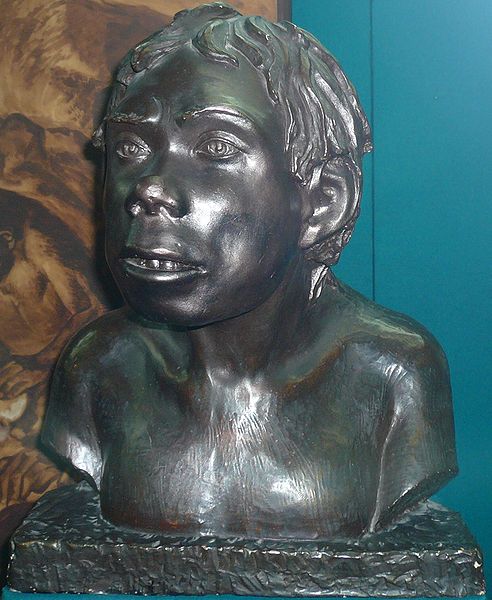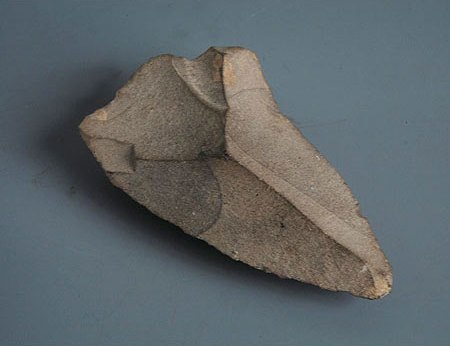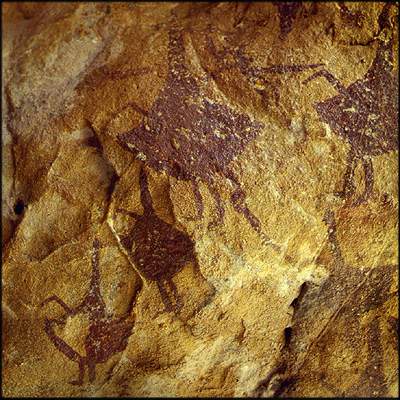|
Category
|
Prehistoric campsites. Cave Teshik Tash. Cave Zarautsay.Сave Teshik Tash
According to the research Okladnikov wrote: "Further excavations have found an unexpected and truly amazing picture, the like of which has not seen even a single researcher: Mousterian skull around the man once in a strict order, apparently on a definite plan in the form of a circle, were placed horns of a mountain goat. This is irrefutable evidence of the fact that there was already a mind, a logical plan of action, a whole world of ideas, which was behind this action. "
Initially it was thought that the remains belong to a boy and his image has become famous out of print around the world, all journals and textbooks. However, according to more recent studies, it was found that the skeleton belongs to a girl.
According to the structure of DNA, which has recently been extracted from the bones of Teshik-Tash child, he is not moving closer to the members of the species Homo sapiens, but with the Neanderthals. Perhaps the Neanderthal species originated in Europe. Part of the Neanderthals could migrate to Asia relatively early, when the special form provided by the man from La Chapelle-o-Seine (France), has not yet been formed. Rock paintings of Zarautsay To date, the territory of Uzbekistan found more than 150 objects from the cave paintings. The oldest of these monuments is unique Zarautsay rock painting. Zarautsay Gorge in south-western spurs of the Hissar range in the Sherabad District to the west of Surkhandarya region. Here in 1912 were discovered caves with rock paintings related to the XII-VIII millennium BC. Over time they became known around the world. The first detailed study of drawings were made G.V.Parfenov in 1940-45 years. The figures depict people preying on the bull and other animals, ritual ceremonies in honor of hunting and much more. So far, in the caves of the Zarautsay gorge survived more than 40 drawings. Their uniqueness lies in the fact that the man of the Stone Age the first time captures the fact that he cares what he lives. With the help of the ocher colors he painted on the stone itself and with others, trying to convey their feelings and experiences about the upcoming event - hunting. It was one of the first attempts of the ancient people to keep and transmit confidential information to others. It is no exaggeration to say that zarautsay hunters were original chroniclers of the Stone Age. Rock paintings in the cave Zarautsay are on a par with fine examples of prehistoric art of expression found in the caves of Castillo, Altamira, Lascaux, Font de Gom (France, Spain), Kapova Cave, Shishkinskaya pisanitsa on the banks of the Lena River (Russia) found at the end of XIX-XX centuries. These famous ancient monuments of art not only represent a stunning realism to the work of primitive art depicting the bison and mammoths, horses and bulls, which served as the main objects of hunting and subsistence of prehistoric man, but also allow for the first time to look into the inner world of our ancestors.
Unfortunately, the unique rock carvings of Zarautsay are threatened with extinction. They are not saved or remoteness from populated areas, or inaccessibility. Tourists "autographs", wind erosion, moisture makes its ruthless business. Thus, in 1940-45 years scientist G.Parfenov revealed in the Zarautsay gorge 27 caves with more than 200 images, in 2001 the Uzbek archaeologist M.Huzhanarov has found just eight caves and about 40 images. It has long been voices about the need to protect the monument. And in 2003 a group of enthusiasts led by Abdullah Holmirzaev passed from words to deeds - was created by a "Zarautsoy" Community Center to study and protect the archaeological site Zarautsay. On the basis of the center started the project "Creation of conditions for eco-tourism in the territory of the monument Zarautsay" which received a grant from the Public Fund of the Oliy Majlis (Parliament) of Uzbekistan. Currently, work is underway on the conservation of rock art of Zarautsay and preserve them as national cultural values. Work is underway to prepare for the nomination to the UNESCO World Heritage List. The true meaning and value of this ancient monument is immeasurably high, because it clearly shows that the territory of Uzbekistan is one of the centers of civilization of mankind. |
 The world-famous cave Teshik Tash (Leaky stone) lies at an altitude of about 1500 m above sea level in the Baysuntau mountains to the north of Surkhandarya region. In this cave in 1938-39 archaeologist Alexey Okladnikov made a sensational discovery of camp of prehistoric Mousterian culture and burial with remains of the skeleton (skull and some bones) of Neanderthal child 8-9 years. Burial was surrounded by the horns of mountain goats, dug into the ground, which may indicate the existence of the religious-ritual worship in Neanderthals.
The world-famous cave Teshik Tash (Leaky stone) lies at an altitude of about 1500 m above sea level in the Baysuntau mountains to the north of Surkhandarya region. In this cave in 1938-39 archaeologist Alexey Okladnikov made a sensational discovery of camp of prehistoric Mousterian culture and burial with remains of the skeleton (skull and some bones) of Neanderthal child 8-9 years. Burial was surrounded by the horns of mountain goats, dug into the ground, which may indicate the existence of the religious-ritual worship in Neanderthals. The skull, discovered in Teshik-Tash is quite large (1490 cu. Cm), characteristic of the Neanderthal brow ridge is not very developed, can be seen protruding nose and chin, as usual with the Neanderthals, is absent. The famous anthropologist, M.M. Gerasimov completely revolutionized the look of a child from Teshik-Tash. The skull, he said, "is much more powerful than a modern skull of the child the same age. The value exceeds the extent of his brow of the modern adult. The forehead is receding. The head is large, heavy, especially in the front part, the growth of small, long torso. He is only 9-10 years, and he looks older than his age. This disparity in the size and shape of the head combined with very strong shoulders and a distinctive stoop across the top of the torso. The hands are very strong. Legs short and muscular. The whole complex of symptoms typical of Neanderthal forms. "
The skull, discovered in Teshik-Tash is quite large (1490 cu. Cm), characteristic of the Neanderthal brow ridge is not very developed, can be seen protruding nose and chin, as usual with the Neanderthals, is absent. The famous anthropologist, M.M. Gerasimov completely revolutionized the look of a child from Teshik-Tash. The skull, he said, "is much more powerful than a modern skull of the child the same age. The value exceeds the extent of his brow of the modern adult. The forehead is receding. The head is large, heavy, especially in the front part, the growth of small, long torso. He is only 9-10 years, and he looks older than his age. This disparity in the size and shape of the head combined with very strong shoulders and a distinctive stoop across the top of the torso. The hands are very strong. Legs short and muscular. The whole complex of symptoms typical of Neanderthal forms. " In the cultural layers of the cave (1.5 m) were found the bones of wild horses, mountain goat, deer, bear and other animals that are hunted residents parking. Valuable finds were numerous stone artifacts (eg, discoid cores, scrapers).
In the cultural layers of the cave (1.5 m) were found the bones of wild horses, mountain goat, deer, bear and other animals that are hunted residents parking. Valuable finds were numerous stone artifacts (eg, discoid cores, scrapers). The figures in the Zarautsay cave clearly distinguished figures of hooded men, threw a wild bull with spears. Alongside the move gazelles, antelopes, mountain wolves. And what is striking: in the time next to a man - a dog. Sometimes the image is superimposed on one another, much more recent origin. According to experts, the image is put on the rocks, covered with a so-called "desert tan" - yellowed by time, with lime mortar. They are located at the height of human growth in the bend of the walls to the ceiling in size from 5 to 15 centimeters. Pounded in the paint served as animal fat ocher, which is rich in Zarautsay, palette - from red-brown to purplish, shaded yellow-beige background.
The figures in the Zarautsay cave clearly distinguished figures of hooded men, threw a wild bull with spears. Alongside the move gazelles, antelopes, mountain wolves. And what is striking: in the time next to a man - a dog. Sometimes the image is superimposed on one another, much more recent origin. According to experts, the image is put on the rocks, covered with a so-called "desert tan" - yellowed by time, with lime mortar. They are located at the height of human growth in the bend of the walls to the ceiling in size from 5 to 15 centimeters. Pounded in the paint served as animal fat ocher, which is rich in Zarautsay, palette - from red-brown to purplish, shaded yellow-beige background.














